Octet rule - Study guides, Class notes & Summaries
Looking for the best study guides, study notes and summaries about Octet rule? On this page you'll find 497 study documents about Octet rule.
All 497 results
Sort by
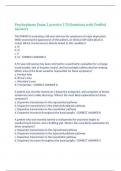 Popular
Popular
-
Psychopharm Exam 1 practice 170 Questions with Verified Answers,100% CORRECT
- Exam (elaborations) • 52 pages • 2023
-
- $11.99
- 1x sold
- + learn more
Psychopharm Exam 1 practice 170 Questions with Verified Answers The PMHNP is evaluating a 68-year-old man for symptoms of major depression. While assessing the appearance of the patient, an obvious left-sided ptosis is noted. Which cranial nerve is directly linked to this condition? a. III b. IV c. V d. VI - CORRECT ANSWER A A 55-year-old woman has been referred for a psychiatric evaluation for a change in personality, lack of impulse control, and increasingly reckless decision-making....
 Popular
Popular
-
Chemistry 1010 Final Clemson University test with verified solutions 2024 latest update.
- Exam (elaborations) • 10 pages • 2024 Popular
- Available in package deal
-
- $14.99
- 1x sold
- + learn more
Molecule Unit of matter that results when two or more atoms are joined by covalent bonds Ionic Bond A bond resulting from the electrostatic attraction of a cation for an anion. Brainpower Read More Nonpolar Covalent Bond A bond characterized by an even distribution of charge; electrons in the bonds are shared equally by the two atoms Polar Covalent Bond A bond resulting from unequal sharing of bonding pairs of electrons between atoms Polyatomic Ions Charged g...

-
Portage Chemistry 219 100% VERIFIED SOLUTIONS CORRECT ANSWER
- Exam (elaborations) • 4 pages • 2023
- Available in package deal
-
- $7.99
- 4x sold
- + learn more
Portage Chemistry 219 100% VERIFIED SOLUTIONS CORRECT ANSWER The lone pairs in a LDD are equal to: - ANSWER The 2 dots The unpaired electrons are equal to: - ANSWER The 1 dot What is the number of bonds an atom can form, equal to? - ANSWER Their unpaired electrons Find the lone pair, the unpaired electrons and the bonds of Oxygen. - ANSWER 2, 2, 2 What is organic chemistry? - ANSWER The study of compounds that contain carbon What is catenation? - ANSWER The ability to form bonds betw...
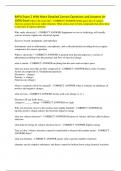
-
BAPA Exam 2 With More Detailed Correct Questions and Answers A+ 100% Excel what is the octet rule? - CORRECT ANSWER-Noble gases have 8 valence electrons and are the most stable elements. Other atoms react to form compounds that allow them to also have 8 v
- Exam (elaborations) • 21 pages • 2024
- Available in package deal
-
- $14.49
- + learn more
BAPA Exam 2 With More Detailed Correct Questions and Answers A+ 100% Excel what is the octet rule? - CORRECT ANSWER-Noble gases have 8 valence electrons and are the most stable elements. Other atoms react to form compounds that allow them to also have 8 valence electrons Why study electricity? - CORRECT ANSWER-Equipment we use in Audiology will usually convert acoustic signals into electrical signals Easier to record, manipulate, and reproduce Instruments such as audiometers, microphone...
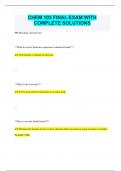
-
CHEM 103 FINAL EXAM WITH COMPLETE SOLUTIONS
- Exam (elaborations) • 52 pages • 2024
- Available in package deal
-
- $11.99
- + learn more
CHEM 103 FINAL EXAM WITH COMPLETE SOLUTIONS ### Questions and Answers **What do Lewis Structures represent in chemical bonds?** The transfer or sharing of electrons --- **What is the octet rule?** Every atom desires 8 electrons in its outer shell. --- **How is an ionic bond formed?** Through the transfer of one or more electrons from one atom or group of atoms to another. Example: NaBr --- **What do metals do in chemical reactions?** Give electrons --- ...

-
CHM 1045 Lab Exam Questions and Correct Answers | Latest Update | A+
- Exam (elaborations) • 31 pages • 2024
- Available in package deal
-
- $13.99
- + learn more
covalent bonds form based on Ans:the sharing of electrons that provides an octet of electrons for each most energetically stable elements in the periodic table Ans:noble gases noble gases are also referred to as Ans:inert gases octet rule Ans:all atoms should strive to have 8 electrons in their outermost shell to achieve the most energetically stable state valence electrons Ans:electrons found in the highest energy shell of an atom (aka the highest principle quantum number, n, shell...

-
General Chemistry TOP Exam Questions And CORRECT Answers
- Exam (elaborations) • 65 pages • 2024
- Available in package deal
-
- $9.99
- + learn more
Describe the atomic differences between Ionic and Covalent bonds. 1. Ionic bonds form between ions and involve gain or loss of electrons, while covalent bonds occur when electrons are shared between two atoms What is the octet rule? List three types of elements that do not follow the octet rule and explain why. Octet rule=atoms tend to bond with other atoms so they have eight outer electrons in their valence shell 1. Elements with incomplete octets, includes: H, He, Li, Be, and B. 2. ...

-
CHEM 120 Final Exam | Questions and Correct Answers | Latest Update 2024/2025 | 100% Pass
- Exam (elaborations) • 58 pages • 2024
- Available in package deal
-
- $11.99
- + learn more
CHEM 120 Final Exam | Questions and Correct Answers | Latest Update 2024/2025 | 100% Pass B - Answer -How many bonds can nitrogen have? Which rule or principle should be used? A) Five bonds; octet rule. B) Three bonds; octet rule. C) Three bonds; the Hund's rule. D) Five bonds; the Aufbau Principle. C - Answer -When two hydrogen atoms meet, they will attract to each other and form a bond (and a H2 molecule). Why? A) Because electrons like to stay together. B) Because electrons li...
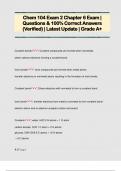
-
Chem 104 Exam 2 Chapter 6 Exam | Questions & 100% Correct Answers (Verified) | Latest Update | Grade A+
- Exam (elaborations) • 20 pages • 2024
-
- $11.49
- + learn more
Covalent bonds: Covalent compounds are formed when nonmetals share valence electrons forming a covalent bond. Ionic bonds: Ionic compounds are formed when metal atoms transfer electrons to nonmetal atoms resulting in the formation of ionic bonds. Covalent bond: Share electrons with nonmetal to form a covalent bond Ionic bond: transfer electrons from metal to nonmetal to form covalent bond - electron donor and an electron acceptor (cation and anion) Covalent: water, H2O 2 H atoms + 1 O ato...
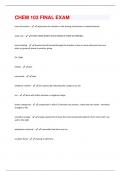
-
CHEM 103 FINAL EXAM QUESTIONS & ANSWERS VERIFIED 100% CORRECT
- Exam (elaborations) • 31 pages • 2024
- Available in package deal
-
- $7.99
- + learn more
Lewis Structures - represents the transfer or the sharing of electrons in chemical bonds octet rule - EVERY ATOM WANTS 8 ELECTRONS IN THEIR OUTERSHELL ionic bonding - chemical bond formed through the transfer of one or more electrons from one atom or group of atoms to another group EX : NaBr metals - give nonmetals - take oxidation number - the superscript indicating the charge on an ion ion - atom with either positive or negative charge binary compound - compounds in which 2 elements a...
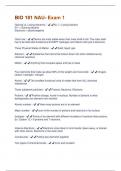
-
BIO 181 NAU- Exam 1 (Questions & Answers) Rated 100% Correct!!
- Exam (elaborations) • 10 pages • 2024
- Available in package deal
-
- $7.99
- + learn more
Gaining vs. Losing electrons - ️️N+1 = Losing electron N-1 = Gaining electron Electrons = electronegative Octet rule - ️️Atoms are most stable when their outer shell is full. The outer shell has to be filled with 8 electrons EXCEPT Hydrogen and Helium with just 2 electrons. Three Physical States of Matter - ️️Solid, liquid, gas Element - ️️Substance that cannot be broken down into other substances by chemical reactions Matter - ️️Anything that occupies space and has a...

That summary you just bought made someone very happy. Also get paid weekly? Sell your study resources on Stuvia! Discover all about earning on Stuvia


